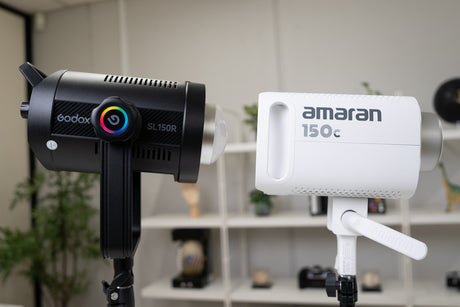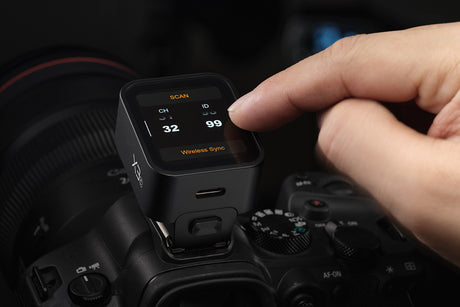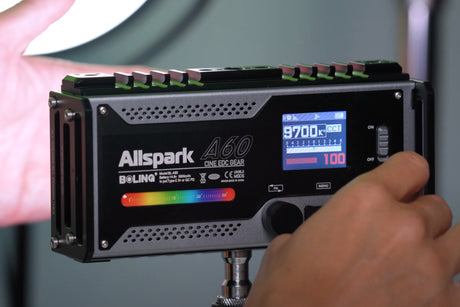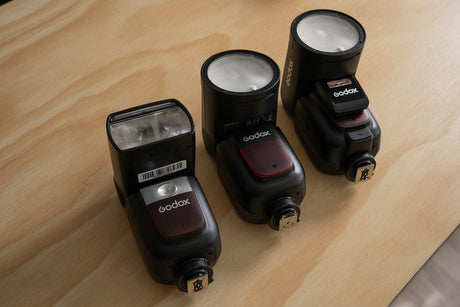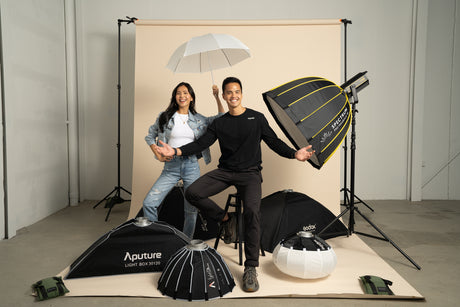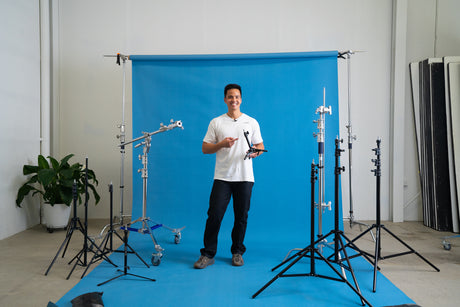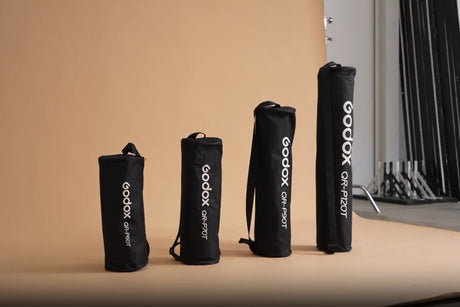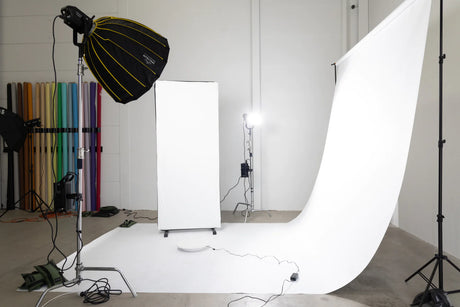YouTube and Podcasting provide extra revenue streams, but content creators must have quality audio for their channels, as discerning viewers and listeners prefer entertainment that is on a professional level. Modern smartphones have advanced video technology, but the audio is sub-standard. To meet the needs of the public, a keen musician, videographer or podcaster using a smartphone must plug an external microphone into their device to match everyone’s
expectations.

What is a Smartphone Microphone?
A smartphone’s internal microphone is a small, sensitive device used to transmit audio when making a phone call or recording a video. Unfortunately, because it is designed to pick up your voice no matter where your phone is held, it also collects background sounds. An external microphone reduces the unwanted noise in your recordings by primarily picking up sound from the direction the mic is pointing toward. Some external microphones are designed to be used with a smartphone to record quality audio when singing, filming videos for Youtube, Instagram, Facebook Live, Tiktok, Snapchat or while making podcasts.
Mobile phones have always included a built-in microphone to capture the voice of the person speaking, but the ability to record from an external microphone didn’t become available until after smartphones incorporated video-capture technology. At this point, it became apparent that the audio quality of built-in microphones required refinement. To keep the shape of smartphones to a minimum, there wasn’t room for a substantial microphone, so manufacturers began creating plug-in mics that produced audio of superior quality.
There are several situations where using an external microphone can be helpful. Capturing a video podcast with the assistance of a microphone will ensure that the audio is clear and of high quality. And if you’re in a noisy environment, using a microphone can help reduce the amount of background noise captured.
Anyone who needs to capture audio on their smartphone will benefit from using an external microphone. This includes musicians, podcasters and videographers. Smartphone microphones add value to content creation through improved clarity of sounds and voices while being convenient, portable and easy to use.
At Hypop, we recommend the Boya and Rode brands. These external microphones are suitable for smartphones and produce superb audio quality. With their ease of use, you’ll be creating podcasts fast and uploading them to Apple Podcasts, Google Podcasts, Spotify, Audible, Stitcher, or TuneIn Radio for the world to enjoy.

Types Of Smartphone Microphones
Each type of smartphone microphone has advantages and disadvantages. They are designed with specific needs in mind. Here is a list of microphone styles that could be useful to you.
Lavalier
A lavalier microphone is a small, clip-on microphone often used in television and film production. The mic is attached to the subject’s clothing, usually near the collarbone, and is hidden from view. Lavalier microphones are popular because they allow for natural, unobtrusive audio capture. The mic is close to the subject’s mouth, so it picks up the voice clearly while filtering out background noise. To connect a lavalier microphone to a smartphone, you will need an adapter that converts the mic’s 3.5mm output to the phone’s input area. There are several advantages to using a lavalier microphone over other microphones. First, the mic is very close to the subject's mouth, so it picks up their voice clearly. Additionally, lavalier mics are tiny, making them ideal for use in situations where a larger mic would be cumbersome or intrusive.
Shotgun Microphone
A shotgun microphone is a type of microphone that is more commonly used in film production, television, and radio. Its name comes from its shape, which resembles a shotgun. Shotgun microphones are known for their directional sound pickup, which allows them to focus on a specific sound source while reducing background noise. This is especially useful in settings where there are many people or many different noises happening at once, allowing for a clear and natural sound. With a plug-and-play operation, the Godox Compact Directional Shotgun Microphone is a lightweight, directional shotgun microphone with an effortless setup so you can start recording instantly. It picks up sound in front of the microphone clearly while reducing the impact of surrounding noises. Supplied with a 3.5mm TRS output cable and a 3.5mm TRRS output cable, this mic can connect to Android smartphones and tablets, as well as cameras and camcorders. A similar device is available for iOS users: the Rode VideoMic Me-L directional microphone for iOS devices attaches through a Lightning connector to provide enhanced audio. It has a microphone clip to ensure the mic is secure and comes with a furry windshield for filming in adverse weather conditions. Another shotgun mic that features a 3.5mm TRS output for use with a camera, plus a digital USB output for recording with mobile devices and computers, is the Rode VideoMic Go II. It’s a lightweight offering that produces heavyweight results. Record video through your smartphone and accompany it with audio through your computer. Or record straight to your iPhone using the Rode SC15 USB Type-C to Lightning accessory cable.
Bluetooth Microphone
A Bluetooth microphone is a small, wireless microphone that uses Bluetooth technology to connect to a device. Bluetooth microphones are popular because they are very portable and easy to connect. To connect a Bluetooth microphone to a smartphone, turn on the Bluetooth feature on the phone and then pair the phone with the Bluetooth microphone. Once the two devices are paired, the microphone can transmit audio to the phone.
USB Microphone
Most USB microphones are condenser mics. Condenser microphones are considered the most versatile recording microphones for vocals and music. Having a USB condenser mic connected to your phone enables you to produce studio-quality audio on your smartphone. Using a USB microphone with your smartphone gives you the best of both worlds: the portability of your phone for video and the high-quality audio of a USB microphone. This makes it great for recording a solo podcast, gaming, live streaming, or any other situation where you need to be heard clearly. The Godox Geniusmic UC Ultracompact Smartphone Microphone is a prime example of an ultra-compact USB Type-C mic that provides higher-quality sound capture than a smartphone’s built-in microphone. In the package is a foam windscreen and a furry windshield to protect against noise from the wind when shooting outdoors. The Geniusmic UC has a USB Type-C male plug to enable connectivity with smartphones and tablets with a USB Type-C port. Recording indoors is made easy with the Godox EM68G RGB USB Microphone. It’s a desktop model with a built-in shock-absorbing base that minimises the sounds of bumps and knocks. Connect this stylish microphone to your smartphone via Bluetooth for interviews, podcasts and YouTube tutorials.

Types of Connectors
Microphones are used for various purposes; therefore, they are attached to devices through specific connectors. Connectivity from an external microphone to a smartphone is often achieved wirelessly by Bluetooth, the headphone jack, or the charger port. Here are some of the standard connectors used by microphones.
Lightning Connector
The iPhone 7 (and above) connects a microphone through its Lightning port. Most of the compact mics from Hypop plug into this port directly, but with some, a separate adapter is required.
USB Type-C Connector
The USB Type-C port is a connector for mobile devices, including the top Android phones. The Boya BY-WM4 Pro-K5 Wireless Microphone System for Android and other Type-C Devices is ideal for YouTubers, vloggers, and podcasters.
USB
Connecting a USB microphone to a smartphone through an appropriate cable and connector doesn’t usually work because USB microphones need more electrical current than a phone can provide. These microphones must receive power from another source and use the phone’s port to receive the audio.
TS & TRS
The 1/8″ TRS microphone jack will accept microphones with TS and TRS connections.
TRRS
Designed for smartphones, TRRS mics can plug into and send audio through your phone's headphone jack.
XLR
To use a professional XLR-based microphone with an iPhone, you need an XLR-Lightning adapter cable. The Rode PodMic Broadcast-Grade Dynamic Microphone is a good example of an XLR mic that gives your vocals a rich, warm, full-bodied sound. With an internal pop filter, an internal shock mount for reducing vibrations, and a swing mount for easy positioning, it’s been designed specifically for speech. Being a dynamic mic, it doesn’t pick up as much noise and reverberation within a room, so it’s perfect for podcasting and live-streaming.
Wireless
Need some distance between yourself and your smartphone but still want professional audio? A wireless mic has the advantage of portability, comfort, and ease of connectivity. With the Godox MoveLink M2 2.4GHz Wireless Microphone, you can attach the mic to your jacket or slip it into the adapter to hold it in your hand. Use the 3.5mm TRS/TRRS cable to plug in your smartphone, and you have manoeuvrability and quality. The Boya BY-WM4 Pro-K3 Wireless Microphone System for IOS Devices overcomes the need for cables by plugging the receiver straight into the Lightning port. The lavalier mic clips to clothing as near as possible to the face while its transmitter is tucked into a pocket or attached to a belt. What if you are interviewing someone? The Rode Wireless Go II Dual Channel Wireless Microphone System has a receiver and two transmitters. The transmitters are supplied with twist-and-lock furry windshields for recording in windy weather.

Additional Features
Size
The size of an external microphone must be considered when used in conjunction with a smartphone. Some microphones are too large to fit comfortably on the phone and require extra brackets, while others are too small to pick up sound well. The ideal microphone size for a smartphone will depend on the make and model of your phone, as well as the nature of the recording.
Software Compatibility
Always check your smartphone’s compatibility with the type of microphone you intend to purchase. If you’ve purchased the right mic for your device, the recording or communication software will fire up as soon as you plug it in. If it doesn’t work, your apps may have problems. Check the apps using the microphone by going to Settings / Apps / App Permissions / Microphone Permissions.
Budget
Using an external microphone on a smartphone is a clever way to improve sound quality without over-stretching your budget. Lavalier (lapel) and shotgun mics offer the best value, but if you want high production values, you can’t beat studio-style USB or XLR microphones through adapters.

How to Choose the Best Smartphone Microphone for Your Needs
When recording interviews for podcasts or vlogging, it’s clear that you need an external microphone to lift the standards of the audio. We’ve already covered different styles of microphones, but before making a final choice, there are other factors to consider.
Mobility
When considering an external microphone for a smartphone, it is important to have portability. Many high-quality external microphones on the market are small and light enough to be easily carried in a pocket or purse, making them an excellent option for those who want to record audio on the go.
Polar Patterns
Polar patterns on an external microphone typically include omnidirectional, cardioid, and bidirectional. A polar pattern defines how much audio the microphone will pick up from different directions. Omnidirectional means that the microphone picks up sound equally from all directions. Cardioid (also known as unidirectional) means that the microphone picks up sound mainly from the front, with some from the sides and none from the back. Bidirectional means that the microphone picks up sound mainly from the front and back, with some from the sides. The Rode VideoMic Me-L is an example of a directional microphone suitable for iPhones. Its directionality minimises the impact of surrounding noises, so the focus remains on the action in front of you. The Rode VideoMic Me-C is the same form of directional device, but it’s suitable for any Android phone.
Connectivity & Compatibility
Most Android smartphones have a 3.5mm jack that you can use to connect an external microphone. However, not all external microphones are compatible with all smartphones. For example, some microphones use a USB-C connection, while others use a Lightning connection. Make sure to check the compatibility of your microphone before you try to connect it to your smartphone.
Ease of Use
Enhancing the audio of a video or podcast is the main reason why people want an external microphone for a smartphone. Still, ease of use is another factor that must be considered. If you are recording outdoors and while moving around, a small, unidirectional microphone that plugs straight into the smartphone is more convenient than holding an independently-powered desktop USB microphone on a cable. But in other situations, such as when interviewing, it’s more appropriate to use a paired system of wireless microphones. A simple setup reduces preparation time and means you can start filming faster.
Comparison Table
|
|
Type Of Microphone
|
Size |
iOs/ Android |
Connectivity |
Polar Pattern |
Frequency Range |
UHF or 2.4GHz |
Uses |
Pros |
Cons |
|
Godox Geniusmic UC Ultracompact Smartphone Microphone with USB Type-C Connector |
Condenser |
Length: 80 mm
Weight: 41 g |
iOS / Android |
USB Type-C |
Hypercardioid |
50 Hz to 20 kHz |
N/A |
Vloggers, livestreamers, videographers, and mobile journalists. |
Affordable and compact. User-friendly. No batteries required. |
Good for casual podcasts, but not for professional use. |
|
Directional |
Length: 180 mm Diameter: 21 mm
Weight: 80 g
|
Android |
Standard 3.5mm TRS /TRRS output cables. |
Cardioid |
100-20kHz |
N/A |
For vloggers, livestreamers, videographers, and mobile journalists. |
Simple plug and record design. No battery required. The Shockmount prevents unwanted vibration noises caused by body movement and device operations. |
Good for vocals but not for music. |
|
|
Condenser |
Height: 186 mm (without mount) 221 mm (with mount)
Mic weight: 247 g Mount weight: 412 g |
Compatible with Windows 7, 8, and 10 as well as macOS. |
USB-C port |
Cardioid |
20 Hz to 20 kHz |
N/A |
Made for e-Sports players, live streamers, podcasters, and conferencing. |
The quick-tap mute button. Built-in shock-absorbing bracket. |
Good for desktop or studio use, but not for outdoor recording. |
|
|
Condenser |
Size: 73.5 x 25.7 x 20.2 mm
Weight: 28 g |
iOS |
Lightning Connector |
Cardioid |
20 Hz-20 kHz |
N/A |
Vlogging and podcasting. |
No battery required. |
For best results, this mic needs to be within a metre of the person being recorded. |
|
|
Rode VideoMic Go II Lightweight Shotgun Microphone
|
Condenser |
Height: 120 mm Diameter: 21.6 mm
VideoMic GO II and included accessories: Length: 150 mm Width: 70 mm Height: 86 mm
Weight: 33 g Weight with accessories: 96 g |
iOS and Android |
USB-C (USB 2.0) |
Supercardioid |
20Hz - 20kHz |
N/A |
Filmmaking, podcasting and vlogging. |
Lightweight shotgun style of mic. Can be used with cameras, desktop computers and smartphones. |
There are no physical buttons on the mic so to change any of the advanced features you must do that via the app. |
|
Rode PodMic Broadcast-Grade Dynamic Mic Optimised for RODECaster Pro |
Dynamic |
Length: 172 mm Width: 109 mm Height: 62 mm
Weight: 937 g |
Can be used with iOS or Android if using a compatible cable. |
XLR |
Cardioid |
20Hz - 20kHz |
N/A |
Great for livestreaming on Twitch to record a professional podcast |
It features an in-built pop filter, making it easy to achieve that rich, classic 'radio' sound heard on the best podcasts. |
Not easily portable. |
|
Rode Wireless Go II Dual Channel Wireless Microphone System
|
Condenser |
Transmitter: 44 × 45.3 × 18.5 mm Receiver: 44 x 46.4 x 18.5 mm
Weight of transmitter: 30 g Weight of receiver: 32 g |
Can be used with iOS or Android if using a compatible cable. |
3.5mm TRS lavalier microphone input. |
Omnidirectional |
50Hz – 20kHz |
2.4GHZ |
For filmmakers, on-camera presenters and vloggers. |
Universal compatibility with cameras, mobile devices and computers. Wireless. |
Being omnidirectional, channel separation may be less precise than with a directional microphone.
Expensive compared to other devices. |
|
Godox MoveLink M2 2.4GHz Wireless Microphone System With Charging Case
|
Condenser |
Size: 50 x 40 x 14 mm
Weight: 27 g |
Can be used with iOS or Android if using a compatible cable. |
3.5mm TRS lavalier microphone input. |
Omnidirectional |
50Hz - 20kHz |
2.4GHz |
For vloggers, YouTubers, speakers, interviewers and filmmakers. |
With optional accessories, the MoveLink can convert to a handheld microphone. |
Being omnidirectional, channel separation may be less precise than with a directional microphone. |
|
Boya BY-WM4 Pro-K3 Wireless Microphone System for IOS Devices |
Lavalier |
Transmitter: 45 x 70 x 35 mm Receiver: 82 x 30.7 x 12 mm
Weight of transmitter: 47 g Weight of receiver: 12 g |
iOS |
Lightning connector. |
Omnidirectional lavalier microphone. |
35Hz - 14kHz |
2.4GHz |
Ideal for Youtubers, vloggers, podcasters, TikTok and mobile journalism. |
60 metre operational range (without obstacles). |
Picks up background noise in loud environments. |
|
Boya BY-WM4 Pro-K3 Wireless Microphone System for IOS Devices
|
Lavalier |
Transmitter: 45 x 70 x 35 mm Receiver: 82 x 30.7 x 12 mm
Weight of transmitter: 47 g
Weight of receiver: 12 g |
Android |
3.5mm mini jack and Type-C. |
Omnidirectional lavalier microphone. |
35Hz - 14kHz |
2.4GHz |
Ideal for Youtubers, vloggers, podcasters, TikTok and mobile journalism. |
60 metre operational range (without obstacles). |
Picks up background noise in loud environments. |
|
Rode VideoMic Me-C Directional Microphone for Android Devices
|
Directional |
Size: 73.5 x 25.4 x 20.1 mm
Weight: 27 g |
Android |
USB Type-C |
Cardioid |
20Hz - 20kHz |
N/A |
Vlogging and podcasting. |
Works seamlessly with the RØDE Reporter App, Camera, and other recording apps. |
For best results, this mic needs to be within a metre of the person being recorded. |
Final Thoughts
When recording audio on a smartphone, using an external microphone can result in significantly better sound quality. Unlike the built-in microphone on a smartphone, an external microphone can be directed towards the sound source, resulting in less ambient noise. In addition, external microphones typically have a better frequency response than the built-in microphone on a smartphone, resulting in clearer, more accurate audio.












